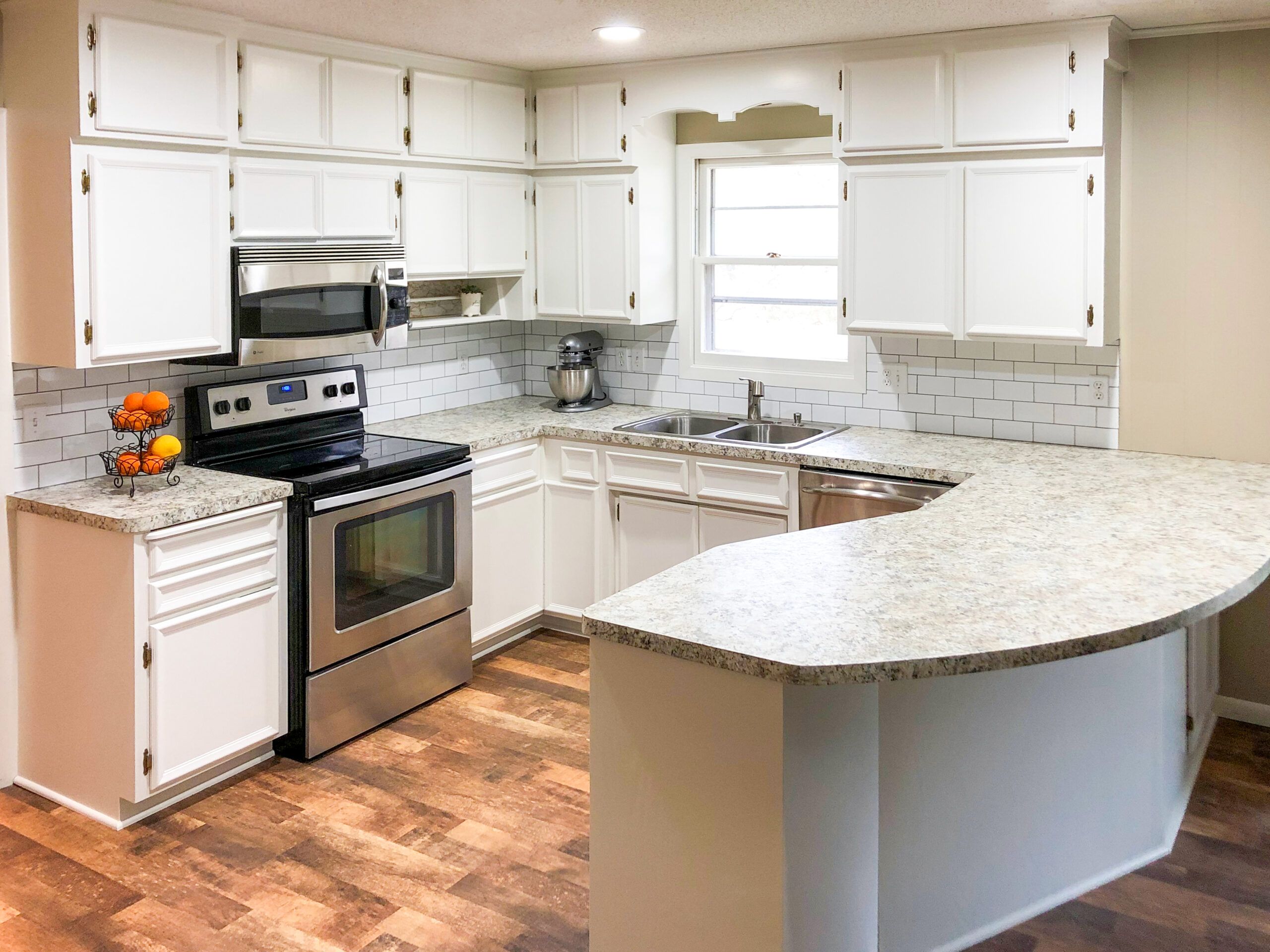How to replace kitchen countertops? It sounds daunting, like wrestling a granite kraken, but fear not, intrepid kitchen renovator! This isn’t some arcane ritual requiring ancient incantations and a sacrifice of stale croissants. With a little planning, the right tools, and a healthy dose of elbow grease (and maybe a caffeine IV drip), you can transform your kitchen from drab to fab.
We’ll guide you through choosing the perfect countertop material, measuring like a pro, safely removing the old, and installing the new, all while keeping your sanity (mostly) intact.
From the initial assessment of your existing countertops and the selection of a suitable replacement material, to the meticulous process of demolition, installation, and finishing touches, we’ll cover every aspect in detail. We’ll even tackle those pesky budgeting concerns and offer tips to avoid common pitfalls that could turn your dream renovation into a kitchen nightmare.
Prepare for a countertop transformation that will leave you speechless (and maybe slightly sore).
Choosing the Right Countertop Material: How To Replace Kitchen Countertops
So, you’re ready to ditch those tired, outdated countertops and embark on a kitchen renovation adventure? Fantastic! But before you dive headfirst into a sea of granite, quartz, and laminate, let’s navigate the wild world of countertop materials. Choosing the right one is like picking the perfect pair of shoes – you want something stylish, durable, and comfortable for the long haul (because let’s face it, your countertops see a lot of action).
Granite, Quartz, Laminate, and Butcher Block: A Durability Showdown
Each material brings its own unique strengths and weaknesses to the table. Think of it as a countertop Olympics, where durability, cost, maintenance, and aesthetics are the key events.
Material Pros and Cons: Cost, Maintenance, and Aesthetics
Let’s break down the contenders, shall we? We’ll weigh the pros and cons, examining their performance in the crucial areas of cost, maintenance, and visual appeal. Remember, the “best” material depends entirely on your individual needs and preferences – your kitchen, your rules!
| Material | Lifespan (Years) | Maintenance Requirements | Cost (Relative) |
|---|---|---|---|
| Granite | 50+ | Sealing every few years; occasional cleaning | High |
| Quartz | 30+ | Regular cleaning; non-porous, requires less maintenance | Medium-High |
| Laminate | 10-15 | Easy cleaning; susceptible to scratches and water damage | Low |
| Butcher Block | 20+ (with proper care) | Regular oiling; prone to water damage if not properly maintained | Medium |
Planning and Measuring
Accurate measurements are the cornerstone of a successful countertop installation. A single miscalculation can lead to a domino effect of frustration, delays, and potentially, costly mistakes. So, grab your measuring tape and let’s get precise!
Step-by-Step Guide to Accurate Measurement
- Clear the countertops: Remove all items to ensure accurate measurements.
- Measure the length and width of each section: Note any irregularities or cutouts.
- Measure the depth: Ensure consistency across all sections.
- Document everything: Create a detailed sketch with measurements for each section.
- Double-check: Accuracy is key! Re-measure to avoid costly errors.
Sink and Appliance Placement: A Crucial Consideration
Before you even think about ordering countertops, carefully plan the placement of your sink and appliances. This will determine the cutouts needed in your new countertops, ensuring a seamless and functional kitchen design.
Countertop Removal and Installation Checklist
- Measuring tape
- Safety glasses
- Gloves
- Putty knife
- Hammer
- Chisel
- New countertops
- Silicone sealant
Removing Old Countertops
Removing old countertops can be a messy and potentially dangerous job. But with the right approach and safety precautions, you can tackle this task with confidence. Think of it as an archaeological dig – carefully uncovering the remnants of the past to make way for a brighter future.
Safe Removal Procedure: Disconnecting Sinks and Appliances
- Turn off water supply: Prevent unexpected flooding.
- Disconnect plumbing: Carefully detach sink and faucet connections.
- Remove appliances: Disconnect and remove any appliances attached to the countertops.
- Carefully remove countertops: Use appropriate tools to avoid damage to surrounding areas.
- Dispose of old materials responsibly: Follow local regulations for waste disposal.
Potential Challenges and Solutions
You might encounter stubborn adhesive, unexpected damage beneath the old countertops, or even embedded screws. Having a plan for these potential hurdles will save you time and frustration.
Safety Precautions: Handling Old Countertop Materials
- Wear safety glasses and gloves to protect yourself from sharp edges and debris.
- Use appropriate tools to avoid injury.
- Be mindful of asbestos if your countertops are older.
- Dispose of materials properly.
Installing New Countertops
With the old countertops out of the way, it’s time to unveil the stars of the show – your brand-new countertops! This phase requires precision and patience, but the end result will be worth the effort. Think of it as a high-stakes puzzle, where every piece needs to fit perfectly.
Installation Process: Cutting, Fitting, and Securing
The installation process varies depending on the material. Granite and quartz often require professional installation due to their weight and the need for specialized tools. Laminate and butcher block, however, are more DIY-friendly.
Discover more by delving into painting a front door like new further.
Visual Representation of the Installation Process
Imagine this: First, you carefully position the new countertop on the cabinets, ensuring it aligns perfectly. Then, you use silicone sealant to create a watertight seal between the countertop and the cabinets. Next, you secure the countertop using appropriate fasteners, ensuring a firm and stable fit.
Finally, you install the sink and faucet, completing the transformation. The final step is to admire your handiwork and bask in the glory of your newly renovated kitchen!
Finishing Touches
The final touches are what truly elevate your countertop installation from “good” to “amazing”. These details ensure the longevity and beauty of your new countertops, making your kitchen a space you’ll love for years to come.
Sealing and Protecting New Countertops
Sealing is crucial for protecting your countertops from stains and damage. The type of sealant depends on the material; granite, for example, often requires a specialized sealant to maintain its natural beauty and prevent staining.
Installing a New Sink and Faucet, How to replace kitchen countertops
Installing a new sink and faucet can be a straightforward process, but proper installation is crucial for preventing leaks and ensuring functionality. Follow the manufacturer’s instructions carefully.
Maintaining New Countertops: Tips for Longevity
- Regular cleaning with appropriate cleaners.
- Using cutting boards to protect the surface from scratches.
- Using trivets under hot pans.
- Periodically resealing (if necessary).
Budget Considerations
Let’s talk money – a crucial aspect of any home renovation project. Planning your budget carefully will help you stay on track and avoid any nasty surprises. Remember, a well-planned budget is a happy budget!
Sample Budget Breakdown
A realistic budget should include material costs, labor costs (if hiring professionals), and the cost of tools. Remember to factor in unexpected expenses – it’s always wise to have a little extra in your budget just in case.
Saving Money During the Project
- Consider DIY installation if you’re comfortable with the task.
- Shop around for the best prices on materials.
- Reuse existing elements if possible.
Long-Term Cost Savings
Investing in durable countertop materials may seem expensive upfront, but they often offer significant long-term cost savings by reducing the need for replacements and repairs. Think of it as an investment in your kitchen’s future.
Troubleshooting Common Issues
Even the most experienced DIYers can encounter unexpected challenges. Being prepared for common problems can save you time, frustration, and potentially, costly mistakes. Let’s address some common issues and their solutions.
Common Problems and Solutions
Common problems include uneven surfaces, improper sealing, and difficulties with sink installation. Knowing how to identify and address these issues can prevent major headaches.
Preventing Common Mistakes
- Accurate measurements are crucial.
- Use appropriate tools and techniques for each material.
- Follow manufacturer’s instructions carefully.
- Take your time and work methodically.
Frequently Asked Questions
- Q: How long does countertop installation take?A: It varies depending on the size of the kitchen and the material used, but typically takes 1-3 days.
- Q: Can I install countertops myself?A: It depends on your skill level and the material. Laminate is relatively easy, while granite requires professional installation.
- Q: How much does countertop replacement cost?A: Costs vary widely based on material, size, and labor.
Last Word

So, there you have it! You’ve conquered the countertop conundrum! Your kitchen now boasts a stunning new surface, a testament to your DIY prowess. Remember, the journey may have involved some unexpected bumps (and possibly a few dropped tools), but the reward—a kitchen you’re proud of—is well worth the effort.
Now go forth and bask in the glory of your newly renovated culinary kingdom. And maybe treat yourself to that celebratory croissant you almost sacrificed earlier.
Helpful Answers
What’s the average cost of replacing kitchen countertops?
The cost varies wildly depending on the material, size of your kitchen, and labor costs. Expect to spend anywhere from a few hundred to several thousand dollars.
Can I replace countertops myself, or should I hire a professional?
While DIY is possible, especially with laminate, more complex materials like granite require professional skills and tools for proper installation. Assess your skill level honestly!
How long does it take to replace kitchen countertops?
This depends on the complexity of the project and your skill level. Expect a few days to a week for a DIY project, and potentially longer if you hire professionals.
What type of sealant should I use on my new countertops?
The best sealant depends on the countertop material. Consult the manufacturer’s instructions for specific recommendations.




